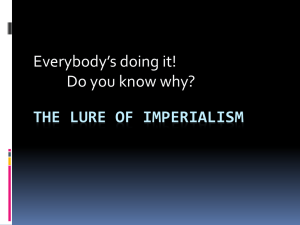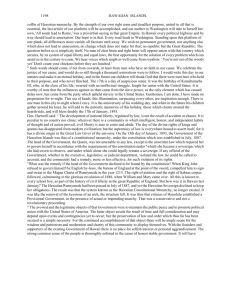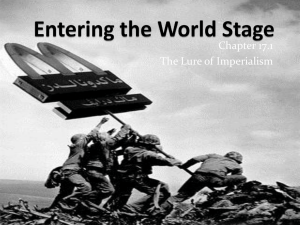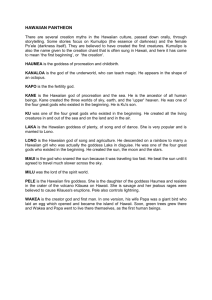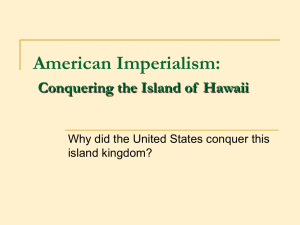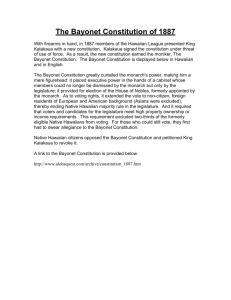Kalākaua - For the Teachers
advertisement
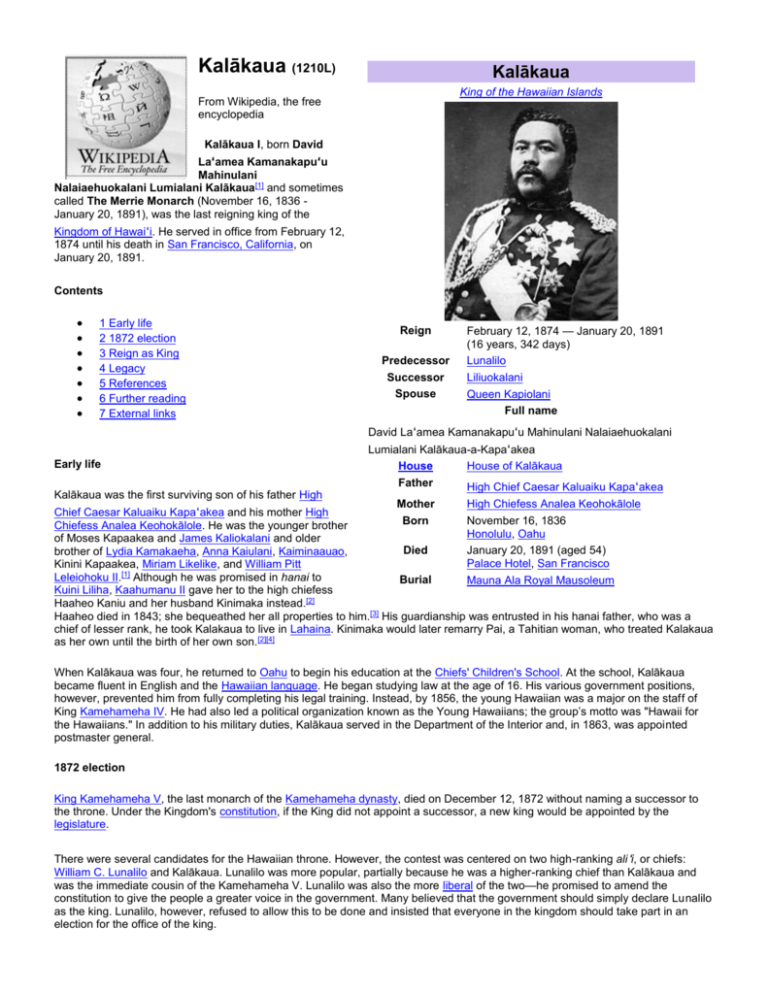
Kalākaua (1210L) Kalākaua King of the Hawaiian Islands From Wikipedia, the free encyclopedia Kalākaua I, born David Laʻamea Kamanakapuʻu Mahinulani Nalaiaehuokalani Lumialani Kalākaua[1] and sometimes called The Merrie Monarch (November 16, 1836 January 20, 1891), was the last reigning king of the Kingdom of Hawaiʻi. He served in office from February 12, 1874 until his death in San Francisco, California, on January 20, 1891. Contents 1 Early life 2 1872 election 3 Reign as King 4 Legacy 5 References 6 Further reading 7 External links Reign Predecessor Successor Spouse February 12, 1874 — January 20, 1891 (16 years, 342 days) Lunalilo Liliuokalani Queen Kapiolani Full name David Laʻamea Kamanakapuʻu Mahinulani Nalaiaehuokalani Early life Kalākaua was the first surviving son of his father High Lumialani Kalākaua-a-Kapaʻakea House House of Kalākaua Father High Chief Caesar Kaluaiku Kapaʻakea Mother High Chiefess Analea Keohokālole Chief Caesar Kaluaiku Kapaʻakea and his mother High Born November 16, 1836 Chiefess Analea Keohokālole. He was the younger brother Honolulu, Oahu of Moses Kapaakea and James Kaliokalani and older Died January 20, 1891 (aged 54) brother of Lydia Kamakaeha, Anna Kaiulani, Kaiminaauao, Palace Hotel, San Francisco Kinini Kapaakea, Miriam Likelike, and William Pitt Leleiohoku II.[1] Although he was promised in hanai to Burial Mauna Ala Royal Mausoleum Kuini Liliha, Kaahumanu II gave her to the high chiefess Haaheo Kaniu and her husband Kinimaka instead.[2] Haaheo died in 1843; she bequeathed her all properties to him.[3] His guardianship was entrusted in his hanai father, who was a chief of lesser rank, he took Kalakaua to live in Lahaina. Kinimaka would later remarry Pai, a Tahitian woman, who treated Kalakaua as her own until the birth of her own son.[2][4] When Kalākaua was four, he returned to Oahu to begin his education at the Chiefs' Children's School. At the school, Kalākaua became fluent in English and the Hawaiian language. He began studying law at the age of 16. His various government positions, however, prevented him from fully completing his legal training. Instead, by 1856, the young Hawaiian was a major on the staff of King Kamehameha IV. He had also led a political organization known as the Young Hawaiians; the group’s motto was "Hawaii for the Hawaiians." In addition to his military duties, Kalākaua served in the Department of the Interior and, in 1863, was appointed postmaster general. 1872 election King Kamehameha V, the last monarch of the Kamehameha dynasty, died on December 12, 1872 without naming a successor to the throne. Under the Kingdom's constitution, if the King did not appoint a successor, a new king would be appointed by the legislature. There were several candidates for the Hawaiian throne. However, the contest was centered on two high-ranking aliʻi, or chiefs: William C. Lunalilo and Kalākaua. Lunalilo was more popular, partially because he was a higher-ranking chief than Kalākaua and was the immediate cousin of the Kamehameha V. Lunalilo was also the more liberal of the two—he promised to amend the constitution to give the people a greater voice in the government. Many believed that the government should simply declare Lunalilo as the king. Lunalilo, however, refused to allow this to be done and insisted that everyone in the kingdom should take part in an election for the office of the king. Kalākaua published a proclamation written in a Hawaiian poetic style. Here is an excerpt: "O my people! My countrymen of old! Arise! This is the voice!" "Ho! all ye tribes! Ho! my own ancient people! The people who took hold and built up the Kingdom of Kamehameha." "Arise! This is the voice." "Let me direct you, my people! Do nothing contrary to the law or against the peace of the Kingdom." "Do not go and vote." "Do not be led by the foreigners; they had no part in our hardships, in gaining the country. Do not be led by their false teachings." Kalākaua was much more conservative than his opponent, Lunalilo. At the time, foreigners dominated the Hawaiian government. Kalākaua promised to put native Hawaiians back into the Kingdom's government. He also promised to amend the Kingdom's constitution. On January 1, 1873, a popular election was held for the office of King of Hawaii. Lunalilo won with an overwhelming majority. The next day, the legislature confirmed the popular vote and elected Lunalilo unanimously. Kalākaua conceded. Reign as King Hawaii State Archives official painting of King David Kalakaua Lunalilo died on February 3, 1874, and Kalākaua was elected to replace him, supported by the legislature although many of the populace, mainly the native Hawaiian and British subjects in the Kingdom, preferred Queen Dowager Emma, who stood against him. Upon ascending the throne, Kalākaua named his brother, William Pitt Leleiohoku, as his heir, putting an end to the era of elected kings in Hawaiʻi. Kalākaua began his reign with a tour of the Hawaiian islands. This improved his popularity. In October 1874, Kalākaua sent representatives to the United States to negotiate a reciprocity treaty to help end a depression that was ongoing in Hawaiʻi. In November, Kalākaua himself traveled to Washington DC to meet Ulysses S. Grant. An agreement was reached and the treaty was signed on January 30, 1875. The treaty allowed certain Hawaiian goods, mainly sugar and rice, to be admitted into the United States tax-free. During the early part of Kalākaua's reign, the king made full use of his power to appoint and dismiss cabinets. King Kalākaua believed in the hereditary right of the aliʻi to rule. Kalākaua continually dismissed cabinets and appointed new ones. This drew criticism from people of the "Missionary Party" who wanted to reform Hawaiian government based on the model of the United Kingdom's constitutional monarchy where the monarch had very little real power over the government but had a position of great dignity and was the head of state. The party believed the legislature should control the cabinet ministers rather than the king. This struggle continued throughout Kalākaua's reign. Journey of King Kalākaua in 1881 In 1881, King Kalākaua left Hawaiʻi on a trip around the world to study the matter of immigration and to improve foreign relations. He also wanted to study how other rulers ruled. In his absence, his sister and heir, Princess Liliʻuokalani, ruled as regent (Prince Leleiohoku, the former heir, had died in 1877). The King first traveled to San Francisco where he was given a royal welcome. Then he sailed to the Empire of Japan where he met with the Meiji Emperor. He continued through Qing Dynasty China, Siam, Burma, British Raj India, Egypt, Italy, Belgium, the German Empire, Austria-Hungary, the French Third Republic, Spain under the Restoration, Portugal, the United Kingdom of Great Britain and Ireland, and back through the United States before returning to Hawaiʻi. During this trip, he met with many other crowned heads of state, including Pope Leo XIII, Umberto I of Italy, Tewfik, Viceroy of Egypt, William II of Germany, Rama V of Siam, President Chester Arthur, and Victoria of the United Kingdom. In this, he became the first king to travel around the world. [5] Coat of Arms of the Hawaiian kingdom, ‘Iolani palace, Honolulu, Hawai’i Kalākaua also built ʻIolani Palace, the only royal palace that exists on American soil today, at a cost of $300,000—a sum unheard of at the time. Many of the furnishings in the palace were ordered by Kalākaua while he was in Europe. Kalākaua decided to erect the Kamehameha Statue in recognition of Kamehameha I, the first king of the whole Hawaiian Islands. The original statue was lost when the ship carrying it sank near the Falkland Islands, so a replacement was ordered and unveiled by the king in 1883. The original statue was later salvaged, repaired and sent to Hawaii in 1912. A third statue was erected in 1969 and is currently the only statue in the United States Capitol that commemorates a native Hawaiian. King Kalākaua is said to have wanted to build a Polynesian Empire. In 1886, legislature granted the government $30,000 for the formation of a Polynesian confederation. The King sent representatives to Sāmoa, where Malietoa Laupepa agreed to a confederation between the two kingdoms. This confederation did not last very long, however, since King Kalākaua lost power the next year to the Bayonet Constitution, and thus a reformist party came into power that ended the alliance. By 1887, the Missionary party had grown very frustrated with Kalākaua. They blamed him for the Kingdom's growing debt and accused him of being a spendthrift. Some foreigners wanted to force King Kalākaua to abdicate and put his sister Liliʻuokalani onto the throne, while others wanted to end the monarchy altogether and annex the islands to the United States. The people who favored annexation formed a group called the Hawaiian League. In 1887, members of the League armed with guns assembled together. The King was frightened by this show of force and offered to transfer his powers to the foreign ministers representing the United States, the United Kingdom, or Portugal. The members of the league instead asked him to sign a new constitution. This new constitution, nicknamed the Bayonet Constitution of 1887, removed much of the King's executive power and deprived most native Hawaiians of their voting rights. The legislature was now able to override a veto by the King, and the King was no longer allowed to take action without approval of the cabinet. The House of Nobles, the house of legislature appointed by the King, was to be elected. It also inserted a provision that allowed non-Hawaiian citizens to vote. A counter-revolution, led by Robert Wilcox, aimed at restoring the King's power, failed. By 1890, the King's health began to fail. Under the advice of his physician, he traveled to San Francisco. His health continued to worsen, and he died on January 20, 1891 at the Palace Hotel in San Francisco. His final words were, "Tell my people I tried." His remains were returned to Honolulu aboard the American cruiser USS Charleston (C-2). Because he and his wife, Queen Kapiʻolani, did not have any children, Kalākaua's sister, Liliʻuokalani, succeeded him to the Hawaiian throne. Legacy King Kalākaua earned the nickname "the Merrie Monarch," because of his love of joyful elements of life. This was a reference to the nickname of the pleasure-loving Charles II of England. Under his reign, hula was revived, which had been banned by Queen Ka'ahumanu in the 1830 after converting to Christianity. Today, his name lives on in the Merrie Monarch Festival, a hula festival named in his honor. He is also known to have revived the Hawaiian martial art, Lua, and surfing. He and his brother and sisters were known as the "Royal Fours" for their musical talents. He wrote Hawaii Ponoi, which is the state song of Hawaii today. King Kalākaua's ardent support of the then newly-introduced ukulele as a Hawaiian instrument led to its becoming symbolic of Hawaii and Hawaiian culture.[citation needed] In Waikiki, an avenue is named after him, "Kalākaua Avenue"; this is the main avenue of Waikiki taking people from the Ala Wai Canal to Waikiki beach as it continues almost until the Diamond Head crater. References 1. 2. 3. 4. ^ a b Christopher Buyers. "Kauai Genealogy". Royal Ark web site. http://www.royalark.net/Hawaii/kauai.htm. Retrieved 2010-02-30. ^ a b Darlene E. Kelley (January 1, 2001). "Kalakaua Part 2". Keepers of the Culture: A study in time of the Hawaiian Islands As told by the ancients. http://files.usgwarchives.net/hi/keepers/koc62.txt. Retrieved 2010-1-28. ^ Supreme Court of Hawaii (1866). Reports of a portion of the decisions rendered by the Supreme Court of the Hawaiian Islands in law, equity, admiralty, and probate. Govt. Press. p. 82-86. http://books.google.com/books?id=6ckDAAAAYAAJ&dq=Kinimaka&lr=&as_brr=3&source=gbs_navlinks_s. ^ Sheldon Dibble (1909). History of the Sandwich Islands. Honolulu: Thomas George Thrum. p. 330. http://books.google.com/books?id=VPlfhWzRz_IC&pg=PR1. Reference: “Kalākaua.” Wikipedia. Retrieved February 26, 2010 from: http://en.wikipedia.org/wiki/Kalakaua KING KALAKAUA: HAWAII'S "MERRIE MONARCH" (990L) In his 54 years of life, King David Kalakaua certainly lived up to his nickname, "The Merrie Monarch." He had a passion for music, dancing, parties, and the finest food and drinks. The king’s reign, however, was also marked by tragedy, pain and dark clouds hovering over the Hawaiian kingdom. Kalakaua was born on November 16, 1836 in Honolulu. His parents were the high chief Kahana Kapaakea and the high chiefess Analea Keohokalole. Per Hawaiian custom, the infant was adopted by the chiefess Haaheo Kaniu, who took him to the court of King Kamehameha III on the island of Maui. When Kalakaua was four, he returned to Oahu to begin his education at the Royal School. Aloha shirts come in many colors and designs. Fluent in English and Hawaiian, Kalakaua took to studying law at the age of 16. His various government positions, however, prevented him from fully completing his legal training. Instead, by 1856, the young Hawaiian was a major on the staff of King Kamehameha IV. He had also been a leader of a political organization known as the Young Hawaiians; the group’s motto was "Hawaii for the Hawaiians." In addition to his military duties, Kalakaua served in the Department of the Interior and, in 1863, was appointed postmaster general. When Kamehameha V died in December 1872 without having designated an heir, an election was held to determine his successor. Prince William Charles Lunalilo emerged victorious over Kalakaua by a wide margin. On February 3, 1874, however, Lunalilo also died without naming a successor. Another election was held, and Kalakaua won handily over Queen Emma, widow of Kamehameha IV. Supporters of the queen rioted. Kalakaua requested help from American and British warships in the harbor, and the uprising was quelled. Because of the ill feelings, however, the new king’s plans for a lavish celebration were put on hold and his reign began on a modest note. In late 1874, Kalakaua sailed to the United States amid much fanfare. In Washington, he negotiated the Reciprocity Treaty of 1875, which eliminated the tariff on sugar and other Hawaiian products. As a result, Hawaii’s sugar industry boomed and the kingdom enjoyed a period of economic prosperity. Upon his return, Kalakaua moved into his palace with his wife, Queen Kapiolani, the granddaughter of King Kaumualii of Kauai. He decided he needed a more luxurious home, however, and had Iolani Palace built at a cost of $350,000—an unheard of sum at the time. The Hawaiian culture enjoyed a revival of sorts under Kalakaua, including hula and chants. In July 1887, however, an organization called the Hawaiian League forcibly took control of the government and presented the king with a new constitution. Called the "Bayonet Constitution" (for obvious reasons), Kalakaua had little choice but to sign it. The new constitution severely restricted his powers and signaled the end of the monarchy. In November 1890, an ill Kalakaua sailed to California for medical treatment. He died at a hotel in San Francisco on January 20, 1891. His final words were, "Tell my people I tried." Photo Credits:Photo1: to 3: Courtesy Hilo Hattie Reference: “King Kalakaua: Hawaii’s ‘Merrie Monarch’.” Aloha-Hawaii.com. Retrieved February 26, 2010 from http://www.alohahawaii.com/hawaii/king+kalakaua/ Virtual American Biographies Over 30,000 personalities with thousands of 19th Century illustrations, signatures, and exceptional life stories. Virtualology.com welcomes editing and additions to the biographies. David Kalakaua (1180L) KALAKAUA, David, king of Hawaii, born 16 November, 1836. He is descended from one of the chief families of the Sandwich islands, received a good education, including a familiar knowledge of the English language. When King Kamehameha died in 1872, he was a candidate for the throne, but his opponent, Williaam Lunalilo, was elected by the people, and confirmed by the legislature. The latter died within a year, and in February, 1874, Kalakaua was elected to the vacant throne by a legislature that had been convened for the purpose. Ex-Queen Emma, the rival candidate, received six votes in the assembly, to thirty-six for him. The partisans of Queen Emma provoked disorders, which were quelled by the intervention of English and American marines. In the autumn of 1874 the king set out on a tour of the United States and Europe. He was conveyed to San Francisco in a steam frigate, placed at his disposal by the American government, arriving in that city on 28 November On 10 July 1887, after some political excitement, he signed a new constitution, limiting the prerogatives of the crown. His wife, Kapiolani, born 31 December 1835, received a native education, and adheres to the national customs. She founded in Honolulu a home for the children of lepers. In the spring of 1887 she visited the United States, and in the summer was a guest of the queen of England on the occasion of the jubilee memorial. His sister, Lydia gamekaeha Liliuokalani, was nominated to be his successor by Kalakaua, who has no children. In 1879 the princess, who speaks the English language fluently, visited San Francisco. She is accomplished in music, and has composed some native hymns. She is married to Colonel JOHN O. DOMINIS, an Englishman, born in 1830, who is commander-in-chief of the Hawaiian military forces, and was formerly governor of the island of Oahu. The princess and her husband accompanied Queen Kapiolani on her visit to the United States in 1887. The queen-dowager, Emma Kaleleonalani, born in Honolulu, 2 January, 1836; died there, 25 April, 1885, was the daughter of a chief of high rank by an English woman, and was adopted into the family of Dr. Rooke, an English physician, settled in the islands, who had married her aunt. She received a good English education, and married King Kamehameha on June 19, 1856. In 1865-'6, after the death of her husband, she visited the United States and Europe. Her only child died at the age of four years. She founded the Kamehameha hospita1 in Honolulu, and left her large estate in trust for the benefit of the Anglican mission. Reference: “David Kalakaua.” Virtual American Biographies. Retrieved February 26, 2010 from http://www.famousamericans.net/davidkalakaua/ David Kalakaua: Brief History (700L) An election was held in 1874 after Lunalilo’s death. Kalakaua ran against widowed queen Emma. Kalakaua won in a close race. Emma's supporters started a riot that had to be stopped by American and British soldiers. Kalakaua was not related to the Kamehameha line. However, his father, Kapaakea, was great grandson of Kameeiamoku, one of Kamehameha I's strongest supporters. On his mother's side, Kalakaua was related to other Kona chiefs. Kalakaua was educated at the Royal School. Kalakaua held positions in the palace under Kamehameha IV. He served 13 years in the legislature. One of Kalakaua's first actions as king was to take a tour of all the islands. He also traveled to Washington D.C. to meet President Lincoln. He became the first reigning monarch ever to visit the United States. He worked to establish a trade treaty. Kalakaua married Kapi`olani in 1873. They had no children. Kalakaua named his younger brother, William Pitt Leleiohoku, as his heir. William died in 1877. Kalakaua named his sister Lili`uokalani as heir. She also acted as regent in his absence. In 1878, Kalakaua took a world tour and visited other heads of state. When he got back to Hawai`i, he built `Iolani Palace. In 1883, he crowned himself in an official coronation ceremony. In 1886, the Merrie Monarch's Jubilee marked Kalakaua's 40th birthday with a two-week celebration. The celebration included parades, fireworks, hula performances, and a public luau. Kalakaua sent his wife and sister to London the next year as his representatives at Queen Victoria's Golden Jubilee. At that time, sugar profits grew and Hawaii's economy grew rapidly. Business deals and corruption seeped into government. Businessmen wanting more control forced Kalakaua to sign the "Bayonet Constitution" in 1887. This new constitution reduces his power to that of a figurehead. The 1890 legislative session was especially frustrating. Kalakaua left. He sailed to Los Angeles hoping to rest and restore his health. He died there in January 1891 at the Palace Hotel.


